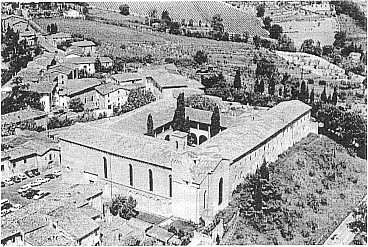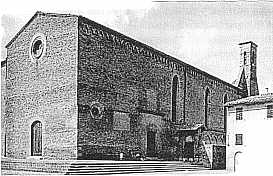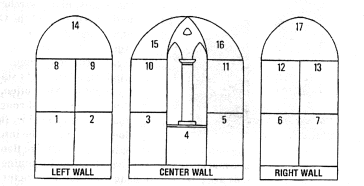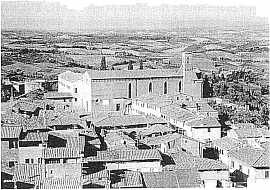Contenuto
Percorso : HOME > English > Pilgrims > St. GimignanoThe Convent of St. Augustine

The Convent of St. Augustine in St. Gimignano
The Convent of St. Augustineá
Two citations from his friend, Possidius' biography of Augustine help one to understand the emphasis on Community, Hospitality, and Simplicity as significant characteristics of the Augustinian way of living the Christian life. Writing about an important decision that Augustine made following his ordination to the priesthood in 389 in Hippo Regius, Possidius notes that "Soon after his ordination, he founded a monastery near the church and began to live there with the servants of God, following the way of life and rule that had been established under the holy apostles.
The most important provision was that no one in that community was to have any property of his own, but rather they were to have all things in common, with each being given what he needed; this was the course Augustine himself had adopted when he had returned home from overseas."
(The Life of St. Augustine 5: 1)
Later in the first biography of Augustine, Possidius describes some other important aspects of Augustinian common life.
"His meals were frugal and economical; at times, however, in addition to herbs and vegetables they included meat for the sake of guests or sick brethren. Moreover, they always included wine, for he knew and taught, with the Apostle, that 'everything created by God is good, and nothing is to be rejected if it is received with thanksgiving; for then it is consecrated by the word of God and prayer. '... Only the spoons were of silver; the vessels in which the food was brought to the table were of earthenware, wood, or marble, and this not by unavoidable povertv but by deliberate policy ..... He practiced hospitality at all times. Even at table he found more delight in reading and conversation than in eating and drinking. "
(The Life or St. Augustine 22: 2, 5, and 6)
The original Augustinian community in San Gimignano was founded in 1272, twenty-eight years after the beginning of the Order of St. Augustine in Tuscany in 1244. There was never a hermitage in this town. Rather, the friars first settled in Racciano, an area less than a mile outside the walls of the small Tuscan town. They built this first convent and small church there.
In a letter, dated 9 (?) July 1272, in which Clement (the prior generai) accepts the bequest of a certain "Brosius quondam Michaelis' who, in his will, had left to the Order two small estates in the neighborhood of San Gimignano (one 'in villa de Racciano," the other "in villa Ste. Lucie') with the stipulation that a monastery and church be erected on one of these two estates. Clement chooses Racciano as the site for the new foundation. "
(Balbino Rano, O.S.A., Augustinian Origins, Charism, and Spirituality, chapter 9, p. 385)
That church, although no longer used for worship, and a small house adjacent to it, is still to be found in Racciano. The friars lived there for but a few years but it was not a comfortable place to life.
Roving bandits and troops from the nearby Republic of Pisa were ready to pillage and plunder whatever they could. Thus fear and the fact that they were somewhat separated from the people prompted the friars to request the townsfolk that they be allowed to build a convent and church within the walls. The inhabitants of San Gimignano not only welcomed the friars; they agreed to extend the northern wall of the town, provided land for the friars and contributed to the construction of the convento and church. Existing records attest to the fact that the town council donated fifty bushels of slaked lime and 20,000 bricks for the construction. That was the beginning of a long history, as well as a warm relationship between the people of San Gimignano and the Augustinian friars that has lasted until today. The official date given for the founding of what is now the convento is 1280. Understandably, Convento Sant' Agostino (the Italian Dame for the house of a Mendicant Order - Franciscan, Dominican, Augustinian, Carmelite - is con-venire, i.e., to come together) was built in stages.
It was connected to the church which was dedicated in 1298. In time, there were three wings to house the community of friars while the church, completed in 1298, served as the fourth side of what, in the fifteenth century, became a very beautiful cloister which remains today. Located along one of the cloister walkways is a room that originally had been the chapter hall of the Augustinian community. This wing of the convento, was begun in the year 1280.
Outside the beautiful windows of this chapter room is the lovely cloister and garden. It is surrounded by the wall of the church and three wings of the convento, each with its two-St.ried arched passageway. The layout of the convento is the classical Augustinian 'forma monasterii', according to which all its friaries were constructed to meet the needs of the friars. The principal door of an Augustinian convento always opened onto a piazza where the townspeople were coming and going, selling and buying and where the children played some kind of game (today soccer; centuries ago, some medieval game).
The conventual church had its sacristy off of its main body. Next in line came the chapter hall where the brothers met to discuss community and important issues. Some of the friars could not read or write; the spoken word was even more important than it is today. This gathering space was always one of the most attractive parts of the convento, with its gothic windows looking out into the cloister and it ribbed arches in the ceiling. Currently, the chapter room is used as a chapel for daily Eucharist for townspeople in the area. On Sunday, Eucharist is celebrated in English for the many English-speaking tourists who visit Sant'Agostino and San Gimignano especially in the spring, summer and winter months.
After the chapter hall carne the calefactorium' or common room where the friars spent time together in conversation and relaxation. It had a fire place in the middle or in one of the walls and was the only room that was heated in winter. In the area known as the 'silentium' or atrium was the St.ne 'lavabo' with its brass faucets (now located in the sacristy) where the friars washed their hands and prepared to enter the 'refectorium' of dining room. The kitchen was nearby as were the cellaria' or St.re rooms (granary, wine cellar, wood pile, animai stalls, etc. On the other side of the complex was the 'foresteria' or hospice with its entrance by way of the main door of the convento so that guests could quietly come and go and the life of the friars would not be disturbed. The community of friars lived above on the second floor. Some interesting more recent hiSt.ry dates back to the middle of the nineteenth century. In 1863, the convento was taken over by the newly established state of Italy, as were almost all religious houses. It was made into barracks for the Bersaglieri of the Italian army. Some of the elderly people who live in near Sant'Agostino still remember hearing St.ries from their parents about files of troops marching out of the convento to take up their posts in the prison up on the hill.
It was returned to the Augustinian Order in 1927 and two friars, Padre Giuseppe Nannini and Fra Giuseppe Frediani, nephew and uncle, moved in bringing tbe friars back after a lapse of sixty-four years. However, then and now, the convento and the church were and are owned by the Italian State. During the bombardments of the town in 1944 (cf. Zaffirelli's film, Tea with Mussolini, people took refuge in the tunnels underneath the convento. They became an air raid shelter. Many older folks recall those days of World War II very well and tell many Stories about them. At the same time, the western wing of the convento was occupied by the Fascist version of the German SS. It was in this place that citizens were detained and interrogated. The townspeople were in constant fear of these 'Republichini'. One of these locals, however, recalls that when everyone had to share the tunnels below, the policemen were most courteous.
It remained a police station of the Carabinieri until 1958. From 1948 to 1968, the part of the convento allotted to the Augustinians was used as the novitiate where Italian young men began their training and preparation for the Augustinian way of life. The older people still talk abut the 'frattini bianchi', the little friars in white, because white is the color of the habit or religious garment of Augustinian novices. Augustinian personalities from San Gimignano include Giuseppe da San Gimignano (XIV century), one of the Blessed of Lecceto, and Domenico Strambi, a theologian, schooled in Paris in the mid thirteenth century who, as prior of the Augustinian community, was responsible for the Renaissance art works in the Church, of particular note, as the one who commissioned the famous Fiorentine painter, Benozzo Gozzoli, to fresco the apse of the church with the life-cycle of St. Augustine of Hippo. This monumental and world famous art work, painted between 1461 and 1465, is located in the choir behind the main altar, an area used by the friars for their daily prayers.
The theologian, Fra Pietro Giraldi (1381) occupies a space beneath the tomb St.ne on the floor near the door of the church. Finally, in more recent times, the sacristan, Fra Romolo, known for his racy St.ries during a tour he game to the United States Congresswoman, Clare Booth Luce, as well as for closing the door on young Prince Charles of the United Kingdom when he arrived late. Fra Romolo did so because it was dinner time for the friars! The community was expanded and became an international Augustinian community in late June of 1995. Currently, the friars offer their home as a place for rest, quiet and prayer with an Augustinian setting and the natural beauty of Tuscany where the Order had its beginning over 750 years ago.
The friars afe available for individual directed Augustinian retreats, for spiritual direction, for group retreats and as companions for Augustinian readings. They also serve as guides to some of the earliest Augustinian foundations in Tuscany offering a rich sense of their origins as a religious order in the Catholic Church.
The Church of St. Augustine

The Church of St. Augustine in St. Gimignano
In chapter two of his Rule, commenting on the centrality of prayer in the life of Community, Augustine writes: "Be assiduous in prayer (Col. 4:2) at the hours and times appointed .... When you pray to God in Psalms and hymns, think over in your hearts the words that come from your lips." (Rule 2: 1 and 3)
The large church in Piazza Sant'Agostino bears the same name as the square where it is located in the northern section of San Gimignano. Construction began around 1280 and the church, of the Romanesque-Gothic style, was dedicated in 1298. Like all of the Augustinian churches built in the early days of the Order of St. Augustine, Sant'Agostino has a very simple fašade with four single Gothic windows on the right side of the building. Most often, theáchurch is entered through the door on the right side; the main door faces west. The interior has a single nave, a trussed ceiling and three, square ogival apses. On the floor, there are eight XIV century grave markers. The two chapels at the beginning of the nave and the altars along the walls are later additions to the originai structure. By far the most famous work of art in the whole church are the seventeen frescoes depicting the life of St. Augustine of Hippo. Anticipated by a triumphal arch in which images of angels and saints are enclosed in false Renaissance niches and covered by four segments of an arch, Gozzoli a well-known thirteenth century Florentine artist painted this world renowned life cycle. It is located in the choir of the church, the place where the friars prayed daily. The work was commissioned by the prior of the community, Domenico Strambi, who had the title of 'Doctor Parisinus' because he had both studied and taught at the Sorbonne in Paris. Gozzoli lived in the convent with the friars for three years, between 1461 and 1464, when he painted both in this church and in the Duomo, the main church of the town.
Thousands of visitors from all over the world come to Sant'Agostino every year, often to see these frescoes and thus come to learn about the great North African saint. The choir of the church, located behind the principal altar, is entirely decorated with a monumental fresco representing a life cycle of St. Augustine of Hippo. This painting was done by Benozzo Gozzoli, a well known Florentine artist, between 1461 and 1465, years in which this mater and his pupils lived in close contact with the friars who lived in the convento. The prior of the Augustinian community, Domenico, assisted Gozzoli in choosing events from St. Augustine's work, The Confessions. Almost all of the scenes come from the book; a few popular legends about Augustine are included as well. Arranged in three series, there are seventeen scenes narrating the life of St. Augustine, from the time the young boy's parents, Patrizio and St. Monica, took him to the grammar teacher in his home town of Thagaste (modern day Souk-Ahras in Algeria), up to bis death on August 28, 430. Gozzoli, a master of perspective gives fullest expression of his skill and ari in these frescoes. His great talent is revealed in the fresco depicting Augustine's departure from Rome for Milan (#7 below). It is interesting to note that the character on the extreme right is a self-portrait of the artist, that he clearly indicates that he painted it at the request of the Augustinian prior, Domenico, and that he dated this particular fresco, 1465. á
The frescoes

The frescoes of St. Augustine in St. Gimignano
Starting from the bottom left, the numbers in the diagram designate the location of the painting, described below with the corresponding number.
1. Young Augustine's parents, Patrick and Monica, take him to the teacher in Thagaste.
2. At the age of nineteen (375), Augustine is admitted to the University of Carthage.
3. St. Monica prays for ber son, Augustine.
4. Augustine sails from Carthage (modern dar Tunis, Tunisia) to Rome, Italy.
5. Augustine arrives at Ostia, the port of Rome, at the mouth of the Tiber River, and is greeted by Symmachus, a famous person of the Manichean sect.
6. Augustine teaches rhetoric and philosophy in Rome.
7. Augustine leaves Rome for Milan (the figure on the right is the self-portrait of Gozzoli, the artist).
8. Augustine is received by St. Ambrose, the Bishop, and Theodosius, the Roman Emperor, in Milan, the center of the Roman Empire at that time.
9. Augustine listens to the preaching of St. Ambrose; St. Monica begs a bishop to convert her son; with Ambrose, Augustine discusses Manichaeism, a philosophical sect to which Augustine belonged for nine years.
10. Augustine reads from St. Paul's Letter to the Romans, 13: 11 - 14, and experiences the climax of his conversion; this is the famous Tolle Lege, Tolle Lege (Take up and Read) or garden scene which Augustine explains in detail in The Confessions. It took place in the autumn of 386 in a garden in Milan.
11. Augustine is baptized in the Cathedral of Milan by St. Ambrose at the Easter Vigil on April 24, 387. This fresco is dated April 1, 1464.
12. This fresco portrays a few popolar legends concerning Augustine; unlike the other scenes, they are NOT based on factual information. Augustine and the Child Jesus at the seashore when Augustine is dissuaded from investigating the mystery of the Blessed Trinity; Augustine explains his Rule to his monks; he visits the hermits at Montepisano in Tuscany.
13. The death of St. Monica at Ostia, the port of Rome, at the age of fifty-six, an event thoroughly discussed by Augustine in Book IX of The Confessions.
14. Augustine, as a consecrated bishop, blesses the people of Hippo Regius (modern day Annaba in Algeria).
15. Augustine converts the heretic, Fortunato.
16. Augustine, in ecstasy, is told of the heavenly joys by St. Jerome.
17. The funeral of St. Augustine, August 28, 430, in Hippo Regius.
A visit to this church offers many other beautiful works of art. From late March until late October, thousands of people visit Sant'Agostino's daily to experience its beauty and to get a sense of a medieval church, cloister and convent of the Augustinian friars.
San Gimignano: The town of the beautiful towers

St. Gimignano country
One of the guide books introducing the town of San Gimignano to tourists begins: "ONCE UPON A TIME .... Perhaps is appropriate to begin a history of this city and its thirteen towers, with these words which begin so many fairy tales. Indeed, these towers, which seem to whisper to the sky, contribute significantly to the fairy-tale charm of this town of Tuscany."
Suffice it say in this little invitation to San Gimignano that it is well worth exploring if one wishes to get a sense of medieval Tuscany with a contemporary flavor. Its history begins in the IVth century B.C. with the Etruscan civilization, continues through its Roman days, and has a wealth of signs of the Middle Ages.
Its towers, originally some seventy in number, were a sign of power and prestige. They also served a practical purpose of enabling merchants to hang and dry cloth that was made in the town. Of some interest are the so called 'twin towers', built to challenge the law of the town that did not allow a tower to be built higher than the municipal building.
These two buildings were used as the scale model after which the World Trade Center was constructed. San Gimignano may have lost its glory and prosperity of centuries ago bui it retains a charm that is captivating. After its fall from power in the Middle Ages, it became a small town again and survived by farming. Yet, the upheavals of the centuries did not destroy the fabric of San Gimignano; it has retained its architectural beauty, its medieval attractiveness, and its fairy-tale charm.
That "Once upon a time ..." can still be experienced today as San Gimignano tells its own story with its towers, its churches, its houses and most of all its inhabitants - its people - to visitors who wander through its cobblestone streets.

